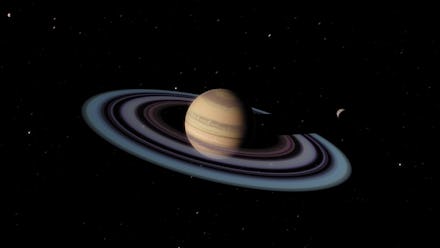Scientists discovered 20 new moons orbiting Saturn, bringing the total to 82

Ever wanted to name your own planet? That's a pretty tall ask, unless you discover one on your own. But your own moon? That's totally doable. Thanks to astronomer Scott Sheppard and his team at the Carnegie Institution for Science, you can do just that soon enough. The team is holding a contest to name all 20 moons they've recently discovered orbiting Saturn, which brings the planet's total moons to 82. This, according to Sheppard, makes Saturn the "new king of moons," in comparison to Jupiter's 79.
"Using some of the largest telescopes in the world, we are now completing the inventory of small moons around the giant planets," said Sheppard. "They play a crucial role in helping us determine how our Solar System's planets formed and evolved."
The discovery was officially announced on Monday, Oct. 7, by the International Astronomical Union's Minor Planet Center. The new moons were discovered by way of the Subaru telescope, found atop Mauna Kea in Hawaii by Sheppard, the University of Hawaii's Jan Kleyna, and David Jewiit of UCLA.
Each of the new moons is about three miles in diameter, with 17 of them orbiting Saturn in a retrograde direction and the others in the prograde. Retrograde indicates that the moons are moving around in the opposite direction of a planet's rotation. That means just three of the newly-discovered moons match Saturn's rotation pattern.
Two of the prograde moons are actually closer to the planet and can take around 2 years to complete one rotation around Saturn. As far as the others go, they can take over 3 years for just one orbit. Those are extremely lengthy time periods when compared to Earth's moon completing an orbit in just 27 days. Earth is much smaller than Saturn, however. Saturn is about 9.5 times bigger than the diameter of the Earth. You could fit approximately 764 of Earth into Saturn, so it makes sense that moons take a lot longer to complete an orbit.
“Studying the orbits of these moons can reveal their origins, as well as information about the conditions surrounding Saturn at the time of its formation,” said Sheppard.
The various ways the moons are grouped around the planet indicate that they may be fragments from what could have been a larger parent moon that was broken down. This is what Sheppard and his researchers surmise, anyway, based on how they moons are seen around Saturn. It's similar to a pattern they observed with Jupiter's many moons.
“This kind of grouping of outer moons is also seen around Jupiter, indicating violent collisions occurred between moons in the Saturnian system or with outside objects such as passing asteroids or comets," Sheppard explained.
As far as how you can go about potentially naming a moon of your own, the contest began Monday, October 7 and is set to run through December 6. All moon name suggestions must be tweeted to the @SaturnLunacy account by way of text, photos, artwork, and videos. You must also include the hashtag #NameSaturnsMoons.
There are a few important rules to keep in mind, however. Given that two of the moons are part of the "Inuit group," a selection of outer moons with inclinations of about 46 degrees, name submissions for these must be giants (think massive beings like the one from Jack and the Beanstalk) taken from Inuit mythology. Seventeen of the moons are retrograde moons in the Norse group and as such must be inspired by Norse mythology. The same goes for the newer moon discovered with an inclination near 36 degrees. It's also further away from Saturn than other moons in its class and it must be named after a giant from Gallic mythology. You can make sure your name isn't already in use via the International Astronomical Union's Minor Planet Center.
Hopefully that doesn't deflate all of your moon-naming dreams since the suggested naming parameters are so specific. But hey, just think about if your name is chosen. You'll have given an official name to one of the moons in our solar system – and that's something to truly be excited about.